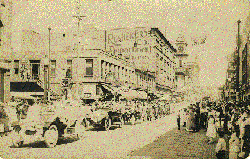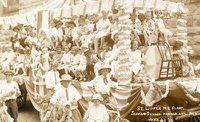Encyclopedia Dubuque
"Encyclopedia Dubuque is the online authority for all things Dubuque, written by the people who know the city best.”
Marshall Cohen—researcher and producer, CNN
Affiliated with the Local History Network of the State Historical Society of Iowa, and the Iowa Museum Association.
SUNDAY SCHOOL PARADE
SUNDAY SCHOOL PARADE. An annual event of Protestant churches in the Dubuque area, the Sunday School parade involved families in elaborate preparations, flags and lots of banners. Eastern cities had similar celebrations years before Dubuque. Led in the Midwest by such cities as Davenport, Moline and Rock Island, Dubuque residents became interested in the activity through the visit around 1908 of Mr. Harry Van Duter, secretary of the Rock Island association. (1) Van Duter met with John E. Hedley of Dubuque who became interested in the idea. An executive committee was formed and Hedley often served as president but also secretary and manager.
The first Sunday School Parade was held on July 20, 1909. There were only a dozen floats, but an estimated three thousand people turned out to watch. (2) The parade continued to grow until by 1920 it was two miles long. (3) Floats were designed to remind people of a passage from the Bible or other religious topic. (4) One year a float portrayed Moses in the bullrushes using a live baby. Another year a float represented Mt. Calvary wide a wide trail leading up to the top of a hill with three crosses. Singers inside sang "In the Cross of Christ Our Lord." Eventually floats mixed with decorated cars, military and church bands, and choirs of marching children and adults. (5) In the 1931 parade, First Congregational Church and Immanuel Congregational Church united their efforts and presented a historical pageant of eight floats. (6)
For his work, John Hedley was eventually given the nickname "Sunday School" Hedley. (7) B. M. Harger served as the first president of the group. During the term of S. B. Lattner, the city attracted the Iowa State Sunday School convention so a parade and picnic were jointly held. The convention was recorded on 2,500 feet of film which was shown around the United States with parts being incorporated into news services. (8)
Among the prizes given for entries was an American flag to the school having the greatest number of married people in the parade. An American flag was also given to the school having the largest number of children and adults in the parade. A prize of ten dollars went to the school having the best float. The same amount of money went to the second best float.
At the conclusion of the first parades, onlookers and participants rode STREETCARS to UNION PARK. (9) The day of the picnic was set for the first Tuesday following the close of Sunday school. Originally the picnic was held in August and then July, but it was found that people were on vacation. (10) In 1931 an estimated ten thousand people came to EAGLE POINT PARK for a picnic as part of the festivities. (11)
"Freight cars" left Summit Congregational Church and St. Luke's Methodist Episcopal Church with all the packages and baskets of food left there by people attending the picnic. The cars from St. Luke's also stopped at RAGATZ'S DRUG STORE and the streetcar barns on Central to pick up more packages of food on their way to the picnic. Each Sunday School was assigned a location in the park. When the freight cars arrived, their loads were distributed to the different locations prior to the arrival of the first passenger cars. Each package was provided with a tag with a number designating the school on one side and the name of the owner on the other. Each location at the park carried the name of the school using that site. (12)
After a meeting of the Sunday Schools on June 18, 1934 the parade was abandoned after its 25th year. (13) It had not be unusual during the years of the parade to find observers arriving from within a one hundred fifty mile radius of the city. (14)
---
Source:
1. "Annual Sunday School Parade and Picnic to be Held Tuesday," Telegraph Herald and Times Journal, June 21, 1931, p. 4
2. "Oh, For the Days of the Big Parade of Sunday Schools," Telegraph Herald, January 25, 1959, p. 4
3. Ibid.
4. Ibid.
5. Ibid.
6. "Record Crowd Out for Sunday School Picnic," Telegraph Herald and Times Journal, June 24, 1931, p. 4
7. "Annual Sunday School Parade..."
8. Ibid.
9. "Picnic Will be Monster Affair," Dubuque Telegraph-Herald, June 25, 1911, p. 15
10. "Annual Sunday School Parade..."
11. "Sunday School Parade, Picnic Workers Meet," Telegraph Herald, Apr. 20, 1931, p. 27
12. "Dubuque Will See Several Thousand in Line of March," Telegraph Herald and Times Journal, June 19, 1927, p. 17
13. "Sunday School Parade to Be Abandoned this Year, Picnic To be Held June 26," Telegraph Herald, June 18, 1934, p. 12
14. "Dubuque Will See..."






